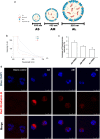Oleic acid-based nanosystems for mitigating acute respiratory distress syndrome in mice through neutrophil suppression: how the particulate size affects therapeutic efficiency
- PMID: 32005196
- PMCID: PMC6995149
- DOI: 10.1186/s12951-020-0583-y
Oleic acid-based nanosystems for mitigating acute respiratory distress syndrome in mice through neutrophil suppression: how the particulate size affects therapeutic efficiency
Abstract
Background: Oleic acid (OA) is reported to show anti-inflammatory activity toward activated neutrophils. It is also an important material in nanoparticles for increased stability and cellular internalization. We aimed to evaluate the anti-inflammatory activity of injectable OA-based nanoparticles for treating lung injury. Different sizes of nanocarriers were prepared to explore the effect of nanoparticulate size on inflammation inhibition.
Results: The nanoparticles were fabricated with the mean diameters of 105, 153, and 225 nm. The nanocarriers were ingested by isolated human neutrophils during a 5-min period, with the smaller sizes exhibiting greater uptake. The size reduction led to the decrease of cell viability and the intracellular calcium level. The OA-loaded nanosystems dose-dependently suppressed the superoxide anion and elastase produced by the stimulated neutrophils. The inhibition level was comparable for the nanoparticles of different sizes. In the ex vivo biodistribution study, the pulmonary accumulation of nanoparticles increased following the increase of particle size. The nanocarriers were mainly excreted by the liver and bile clearance. Mice were exposed to intratracheal lipopolysaccharide (LPS) to induce acute respiratory distress syndrome (ARDS), like lung damage. The lipid-based nanocarriers mitigated myeloperoxidase (MPO) and cytokines more effectively as compared to OA solution. The larger nanoparticles displayed greater reduction on MPO, TNF-α, and IL-6 than the smaller ones. The histology confirmed the decreased pulmonary neutrophil recruitment and lung-architecture damage after intravenous administration of larger nanoparticles.
Conclusions: Nanoparticulate size, an essential property governing the anti-inflammatory effect and lung-injury therapy, had different effects on activated neutrophil inhibition and in vivo therapeutic efficacy.
Keywords: Acute respiratory distress syndrome; Anti-inflammation; Lipid-based nanoparticles; Neutrophil; Oleic acid; Size.
Conflict of interest statement
The authors declare that they have no competing interests.
Figures







Similar articles
-
Oleic acid as the active agent and lipid matrix in cilomilast-loaded nanocarriers to assist PDE4 inhibition of activated neutrophils for mitigating psoriasis-like lesions.Acta Biomater. 2019 May;90:350-361. doi: 10.1016/j.actbio.2019.04.002. Epub 2019 Apr 3. Acta Biomater. 2019. PMID: 30951898
-
Use of cilomilast-loaded phosphatiosomes to suppress neutrophilic inflammation for attenuating acute lung injury: the effect of nanovesicular surface charge.J Nanobiotechnology. 2018 Mar 30;16(1):35. doi: 10.1186/s12951-018-0364-z. J Nanobiotechnology. 2018. PMID: 29602314 Free PMC article.
-
Pulmonary endothelial activation caused by extracellular histones contributes to neutrophil activation in acute respiratory distress syndrome.Respir Res. 2016 Nov 21;17(1):155. doi: 10.1186/s12931-016-0472-y. Respir Res. 2016. PMID: 27871277 Free PMC article.
-
[Progress of neutrophil extracellular traps in airway inflammation of acute lung injury/acute respiratory distress syndrome: Review].Xi Bao Yu Fen Zi Mian Yi Xue Za Zhi. 2020 Jul;36(7):664-670. Xi Bao Yu Fen Zi Mian Yi Xue Za Zhi. 2020. PMID: 32727651 Review. Chinese.
-
Pulmonary drug delivery devices and nanosystems as potential treatment strategies for acute respiratory distress syndrome (ARDS).Int J Pharm. 2024 May 25;657:124182. doi: 10.1016/j.ijpharm.2024.124182. Epub 2024 Apr 30. Int J Pharm. 2024. PMID: 38697584 Review.
Cited by
-
Itraconazole-Loaded Ufasomes: Evaluation, Characterization, and Anti-Fungal Activity against Candida albicans.Pharmaceutics. 2022 Dec 21;15(1):26. doi: 10.3390/pharmaceutics15010026. Pharmaceutics. 2022. PMID: 36678655 Free PMC article.
-
Pequi (Caryocar brasiliense Cambess)-Loaded Nanoemulsion, Orally Delivered, Modulates Inflammation in LPS-Induced Acute Lung Injury in Mice.Pharmaceutics. 2020 Nov 11;12(11):1075. doi: 10.3390/pharmaceutics12111075. Pharmaceutics. 2020. PMID: 33187057 Free PMC article.
-
Development and Characterization of In Situ Gelling Nasal Cilostazol Spanlastics.Gels. 2025 Jan 22;11(2):82. doi: 10.3390/gels11020082. Gels. 2025. PMID: 39996625 Free PMC article.
-
Scd-1 deficiency promotes the differentiation of CD8+ T effector.Front Cell Infect Microbiol. 2024 Feb 6;14:1325390. doi: 10.3389/fcimb.2024.1325390. eCollection 2024. Front Cell Infect Microbiol. 2024. PMID: 38379772 Free PMC article.
-
Ammonium Glycyrrhizinate and Bergamot Essential Oil Co-Loaded Ultradeformable Nanocarriers: An Effective Natural Nanomedicine for In Vivo Anti-Inflammatory Topical Therapies.Biomedicines. 2022 Apr 30;10(5):1039. doi: 10.3390/biomedicines10051039. Biomedicines. 2022. PMID: 35625775 Free PMC article.
References
-
- Carrillo C, Cavia DM, Alonso-Torre S. Role of oleic acid in immune system; mechanism of action; a review. Nutr Hosp. 2012;27(4):978–990. - PubMed
-
- Gonçalves-de-Albuquerque CF, Medeiros-de-Moraes IM, de Jesus Oliveira FM, Burth P, Bozza PT, Faria MVC, Silva AR, de Castro-Faria-Neto HC. Omega-9 oleic acid induces fatty acid oxidation and decreases organ dysfunction and mortality in experimental sepsis. PLoS ONE. 2016;11(4):e0153607. doi: 10.1371/journal.pone.0153607. - DOI - PMC - PubMed
MeSH terms
Substances
Grants and funding
LinkOut - more resources
Full Text Sources
Other Literature Sources
Research Materials
Miscellaneous

